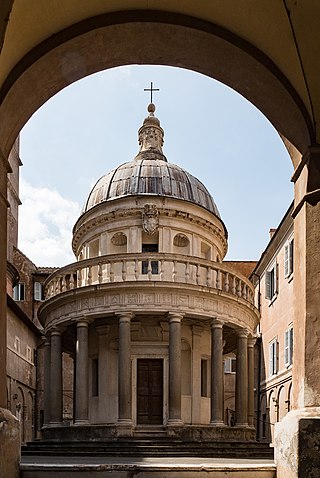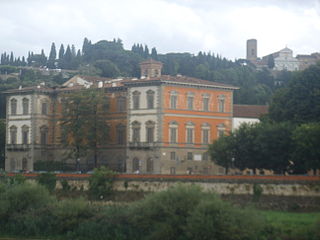
Palazzo Malenchini Alberti is a palace in Florence, Italy. It was owned by the Alberti, who had also a tower nearby. [1]

Palazzo Malenchini Alberti is a palace in Florence, Italy. It was owned by the Alberti, who had also a tower nearby. [1]


Until the 15th century, their residence was formed by a series of different houses and workshops, which were unified between 1760 and 1763 under Count Giovan Vincenzo Alberti (1715-1788), a Florentine senator and minister to both Grand-Dukes Francis I and his son Peter Leopold. Count Alberti's son, Leon Battista Alberti, died without heirs in 1836, and the palace passed to a nephew belonging to the Mori Ubaldini family. [2]
Between 1838 and 1839, the Ubaldini's renovated the palace, under the direction of the architect Vittorio Bellini. A new neo-Renaissance façade and a loggia on the northern side of the palace's garden were added between 1849 and 1851 by the architects Odoardo Razzi and Niccolò Salvi. In 1878, the palace was bought at auction by the Duke of Chaulnes (grandson of Honoré Théodoric d'Albert de Luynes, Duke of Luynes), distant descendants of the Alberti. The Duke diedin 1881 and his son and widow left Florence in 1887, after which the palace was sold in 1895 to Marquis Luigi Malenchini from Livorno, whence the modern name. [3]
The palace was damaged during World War II and by the 1966 Flood of the River Arno, and was later restored from 2000 to 2003. [3]

Leon Battista Alberti was an Italian Renaissance humanist author, artist, architect, poet, priest, linguist, philosopher, and cryptographer; he epitomised the nature of those identified now as polymaths. He is considered the founder of Western cryptography, a claim he shares with Johannes Trithemius.

Renaissance architecture is the European architecture of the period between the early 15th and early 16th centuries in different regions, demonstrating a conscious revival and development of certain elements of ancient Greek and Roman thought and material culture. Stylistically, Renaissance architecture followed Gothic architecture and was succeeded by Baroque architecture. Developed first in Florence, with Filippo Brunelleschi as one of its innovators, the Renaissance style quickly spread to other Italian cities. The style was carried to Spain, France, Germany, England, Russia and other parts of Europe at different dates and with varying degrees of impact.

Giuliano da Sangallo was an Italian sculptor, architect and military engineer active during the Italian Renaissance. He is known primarily for being the favored architect of Lorenzo de' Medici, his patron. In this role, Giuliano designed a villa for Lorenzo as well as a monastery for Augustinians and a church where a miracle was said to have taken place. Additionally, Giuliano was commissioned to build multiple structures for Pope Julius II and Pope Leo X. Leon Battista Alberti and Filippo Brunelleschi heavily influenced Sangallo and in turn, he influenced other important Renaissance figures such as Raphael, Leonardo da Vinci, his brother Antonio da Sangallo the Elder, and his sons, Antonio da Sangallo the Younger and Francesco da Sangallo.

The Palazzo Pitti, in English sometimes called the Pitti Palace, is a vast, mainly Renaissance, palace in Florence, Italy. It is situated on the south side of the River Arno, a short distance from the Ponte Vecchio. The core of the present palazzo dates from 1458 and was originally the town residence of Luca Pitti, an ambitious Florentine banker.

Prato is a city and comune in Tuscany, Italy, the capital of the Province of Prato. The city lies north east of Tuscany, in the Florentine plain, at an elevation of 65 metres (213 ft), at the foot of Monte Retaia. With 195,213 inhabitants as of 1 January 2023, Prato is Tuscany's second largest city and the third largest in Central Italy.

Palazzo Rucellai is a palatial fifteenth-century townhouse on the Via della Vigna Nuova in Florence, Italy. The Rucellai Palace is believed by most scholars to have been designed for Giovanni di Paolo Rucellai by Leon Battista Alberti between 1446 and 1451 and executed, at least in part, by Bernardo Rossellino. Its splendid facade was one of the first to proclaim the new ideas of Renaissance architecture based on the use of pilasters and entablatures in proportional relationship to each other. The Rucellai Palace demonstrates the impact of the antique revival but does so in a manner which is full of Renaissance originality.

Villa del Poggio Imperiale is a predominantly neoclassical former grand ducal villa in Arcetri, just to the south of Florence in Tuscany, Central Italy. Beginning as a villa of the Baroncelli of Florence, it was seized by the Medici, became the home of a homicidal and unfaithful husband, and a lavish retreat for a Grand Duchess with imperial pretensions. Later given to Napoleon's sister, it was reclaimed by the hereditary rulers of Tuscany before being finally converted to a prestigious girls' school. During its long history, it has often been at the centre of Italy's turbulent history, and has been rebuilt and redesigned many times.

Palazzo Mozzi or Palazzo de' Mozzi is an early Renaissance palace, located at the end of the Piazza de' Mozzi that emerges from Ponte alle Grazie and leads straight to the palace where via San Niccolò becomes via de' Bardi in the Quartiere of Santo Spirito in the Oltrarno section of Florence, region of Tuscany, Italy. The 13th-century palace housed the gallery of the highly successful antiquarian Stefano Bardini, of which the remnants were left to the commune, where they assembled the Museo Bardini or Mozzi Bardini, displaying Florentine art and artifacts up to the early Renaissance. The gardens elaborated against the hillside behind the palace were added mainly by Bardini.
The Duke of Luynes is a territorial name belonging to the noble French house d'Albert. Luynes is, today, a commune of the Indre-et-Loire département in France. The family of Albert, which sprang from Thomas Alberti, seigneur de Boussargues, bailli of Viviers and Valence, and viguier of Bagnols and Pont-Saint-Esprit in Languedoc, acquired the estate of Luynes in the 16th century.

Palazzo Spini Ferroni is a large Gothic palace located along Via de' Tornabuoni at the corner of Piazza Santa Trinita, in central Florence, region of Tuscany, Italy. It stands across from the church of Santa Trinita.

Honoré Théodore Paul Joseph d'Albert, 8th Duke of Luynes was a wealthy French nobleman and scholar. He is most remembered for the collection of exhibits he gave to the Cabinet des Médailles in 1862, and for supporting the exiled Comte de Chambord's claim to the throne of France. Throughout his life, D'Albert inherited a number of French titles, including Duke of Luynes, de Chevreuse, and de Chaulnes.

The title of Duke of Chaulnes, a French peerage, is held by the d'Albert family beginning in 1621.

Piazza Santa Croce is one of the main plazas or squares located in the central neighbourhood of Florence, in the region of Tuscany, Italy. It is located near Piazza della Signoria and the National Central Library, and takes its name from the Basilica of Santa Croce that overlooks the square.

The Alberti family was a major political and noble family in Florence, allies of the Medicis, with trading agencies across Europe.

The Museo Horne is a museum focusing on art and furnishings of the 14th and 15th centuries, located in the former Palazzo Corsi, on via de' Benci number 6 in Florence, Tuscany, Italy.

Palazzo Serristori is a Renaissance style palace located between Piazza Demidoff and the Lungarno Serristori in Oltrarno, in the neighborhood of San Niccolò of Florence, region of Tuscany, Italy.

Emmanuel Théodore Bernard Marie d'Albert de Luynes, Duke of Chaulnes and Picquigny was a French nobleman.
Louis Emmanuel de Crussol d'Uzès, 14th Duke of Uzès was a French aristocrat and art collector.
Honoré-Louis d'Albert de Luynes, styledDuke of Chevreuse, was a French nobleman.
Paul Marie Stanislas Honoré d'Albert de Luynes, 10th Duke of Chaulnes and Picquigny was a French aristocrat, soldier and writer.
Coordinates: 43°46′1.47″N11°15′32.31″E / 43.7670750°N 11.2589750°E